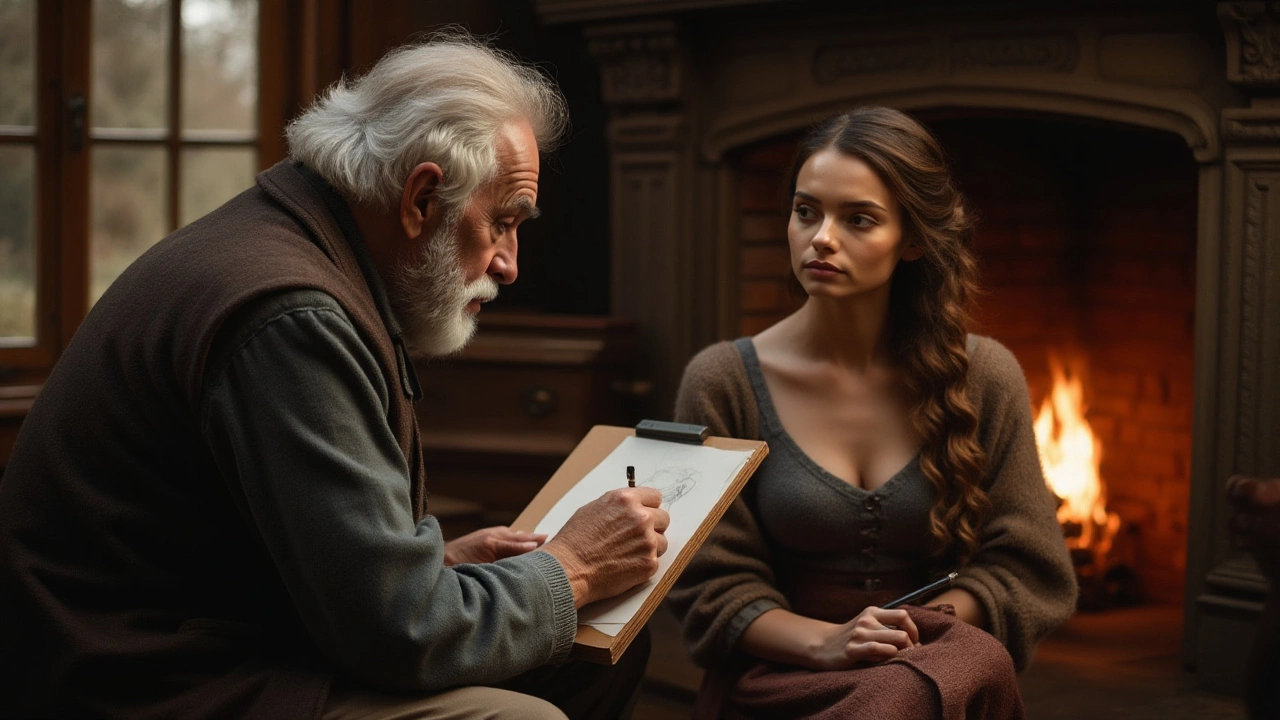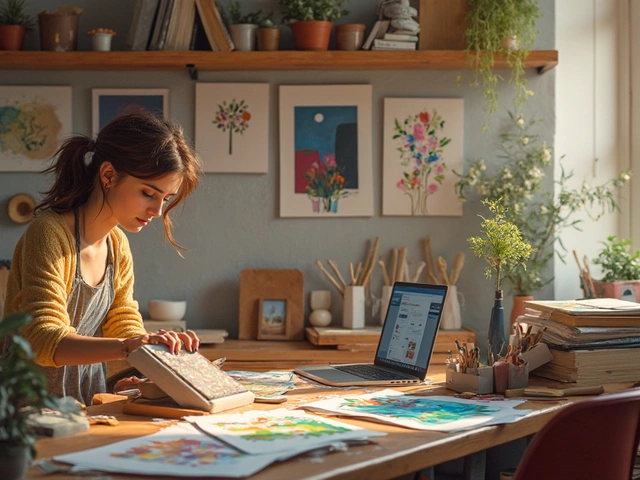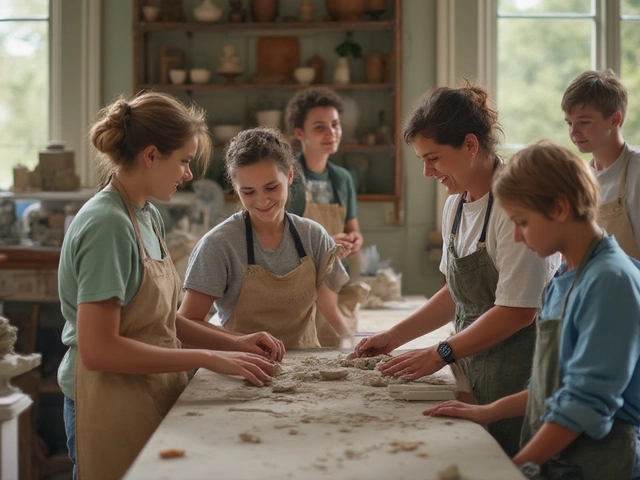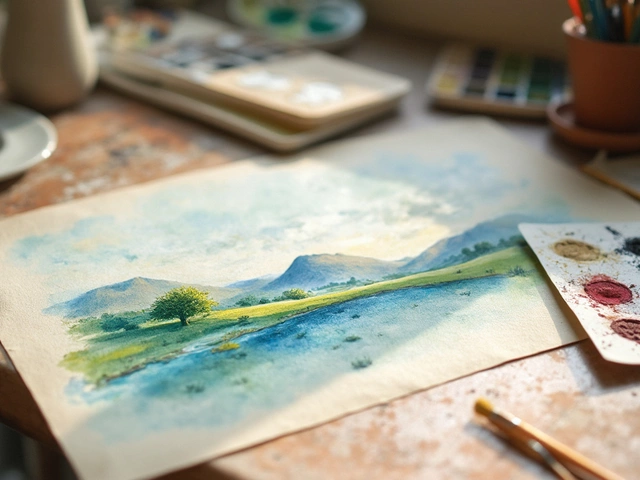Portrait painting can seem daunting, but starting with the right approach makes all the difference. Each stroke, each color choice, connects with a rich tapestry of art history and individual expression. For many, the journey begins with understanding the canvas, the brushes, and most importantly, the subject itself.
There’s a world of techniques that bring faces to life, from the subtle shading of a cheekbone to the sparkle captured in an eye. It's not just about precise anatomy; it's about the stories and emotions that a portrait can convey. The process involves mapping out proportions, playing with light, and letting creativity flow freely. Ready to explore this captivating craft? Let's dive into the essentials that form the heart of portrait painting.
- Understanding Proportions and Anatomy
- Choosing Your Medium and Tools
- Lighting, Composition, and Background
- Capturing Emotion and Personality
- Practice and Patience: Finding Your Style
Understanding Proportions and Anatomy
Diving into the world of portrait painting is like discovering the melody within the music of human existence. To master this art, it's crucial to understand the intricate dance of proportions and anatomy. This knowledge serves as the foundation upon which all great portraits are built. When you look at a face, you're not just seeing a collection of features but a harmonious relationship between them. Each part of the face has its own rhythm and, together, they create a unique visual symphony.
The human face, in its complexity, presents an exciting challenge. Artists have long studied the principles laid out by the likes of Leonardo da Vinci and more modern anatomists to decode this complex puzzle. For example, the eyes are typically positioned halfway down the head, surprising many beginners. This division of the head into equal parts helps maintain balance and symmetry in your art. Even the distance between features like the nose, mouth, and eyes follows a universal pattern. Observing these alignments can enhance the lifelikeness of your work.
"Anatomy is the foundation of art: it is the skilful combination of all aspects of the human body. Only good knowledge ensures that you can express emotions convincingly in portraits," once noted the esteemed painter Édouard Manet.
But it's important to remember that while universal principles exist, each face is unique. Variations in proportion can express individuality and emotion. It's within these deviations from the standardized 'ideal' that a portrait comes truly alive. Artists develop an eye for these subtle differences with time and experience, capturing not only the physical likeness but a glimpse into the soul of the subject as well.
Tools and Techniques for Mastering Anatomy
Incorporating the study of anatomy into your practice doesn't require you to become a medical expert, but familiarizing yourself with the skeletal and muscular structures beneath the skin can deepen your understanding of how and why features align as they do. Sketching exercises, using photographs or models, can be invaluable. Regular practice with these references will instill confidence in your observational skills, allowing for more intuitive creation when working from imagination or live models.
Studying the proportions of the human head can be simplified by using grids or tracing over photographs to understand spatial relationships. Similarly, drawing straight and curved guidelines across your paper can help map out essential anatomical points, providing a scaffold around which you can construct your portrait. This systematic approach enables an artist to develop greater precision, turning what seems complex into a natural part of their artistic process.
Ultimately, embracing the fundamentals of proportions and anatomy enhances not just the technical accuracy of your portraits, but also the emotional depth and authenticity of your subjects. As you progress, you'll find that this knowledge becomes an innate part of your technique, enabling you to express the unique stories and personalities that each face has to offer.
Choosing Your Medium and Tools
When embarking on the art of portrait painting, selecting the right medium and tools is a critical step that shapes the entire creative journey. Your choice of medium can dramatically influence the texture, durability, and even the feel of the finished artwork. Whether you are drawn to the rich, vibrant hues of oil paints or the quick-drying precision of acrylics, each medium offers unique characteristics. Oil paints, with their slow drying time, allow for extended blending and layering, a feature that many artists cherish for creating lifelike textures and depths. On the other hand, acrylics, known for their versatility and quick drying nature, are perfect for artists who favor speed and want to build layers quickly without long waits.
The tools themselves, from the brushes to the canvas, play an equally significant role in how a portrait unfolds. Natural bristle brushes, often used with oil paints, can provide a variety of textures, from smooth strokes to coarse, expressive lines, while synthetic brushes are favored for use with acrylics due to their firmness and precision. Understanding the differences between these materials will enhance your ability to express the subtle nuances of emotion and detail in every portrait. It's not merely about the functionality but also how each tool feels in your hand—a connection every artist develops over time. Be mindful of the surfaces you work on too; canvas, wood panels, and paper each contribute different qualities to your work that can significantly influence the final piece.
“The choice of tools should honor the intent of the artist. It is as much about the heart guiding the hand as it is about the skill behind it.” - Trevor McClure, renowned portrait artist.
Consider starting with a basic set of supplies tailored to your chosen medium. For oils, a selection of primary colors, a couple of bristle brushes, and a suitable canvas can set you on the right path. If your preference is for acrylic, a limited palette can still offer a wide range of mixtures when combined with various types of brushes and tools for texture. The importance of quality materials cannot be overstated, as they not only affect the aesthetics of the art but also its longevity and resilience. Investing in a good set of paints and brushes, while sometimes costly upfront, pays off in terms of quality and fulfillment as you progress in your artistry.
Exploring Digital Mediums
In this modern era, digital mediums have opened up new frontiers for artists. Software like Adobe Photoshop or Procreate offer expansive possibilities at your fingertips, providing endless opportunities to edit and manipulate digital portraits. The digital realm allows artists to experiment freely with colors, brushes, and techniques that can be challenging in physical form. Embracing digital tools can also complement traditional methods, enriching the texture and depth of your artwork without the constraints of drying times and material costs. This fusion of technology and traditional technique expands one’s creative potential and can serve as a bridge between conventional artistry and modern experimentation.
The journey of selecting your medium and tools is deeply personal and often evolves with your growth as an artist. Each choice reflects not just what you create, but how you engage with the process of creation itself. Let your curiosity and passion guide you, and don't hesitate to explore various combinations until you find the perfect fit for your portrait painting explorations.

Lighting, Composition, and Background
When it comes to creating a striking portrait, understanding the interplay of lighting, composition, and background is essential. These elements can significantly affect the mood and impact of your painting. Let's start by exploring light, as it has the power to define features and create contrasts that bring depth to a portrait. Consider the direction from which the light is hitting your subject. Is it natural daylight streaming through a window, or are you using artificial lighting to cast dramatic shadows? The angle and warmth of the light can bring out textures and highlight emotional undertones. Many artists prefer soft, diffused lighting for a gentle look, while others might choose harsh lighting for a more dramatic and intense result. Either way, experimenting with light will help you discover the aesthetic that suits your vision best.
The importance of composition in portrait painting cannot be overstated. Composition is about arranging your subject and elements harmoniously within the frame. A well-composed portrait guides the viewer's eye to the most critical parts of the painting. One classic method is the rule of thirds, which involves dividing your canvas into a grid of nine equal parts. Placing focal points along these lines or their intersections naturally creates balance and interest. However, don’t shy away from breaking the rules for creative expression. Sometimes, centering the face or using unusual angles can lead to compelling results. It's also vital to consider how facial expressions, body language, and props contribute to the narrative you’re creating.
Lastly, let’s turn our attention to the background. This element can either support the subject or become a distraction if not handled thoughtfully. A minimalistic or blurred background often works best, ensuring that it doesn’t compete with the main focus of the portrait. However, when used effectively, backgrounds can add context or symbolism. For instance, landscapes behind a portrait might suggest a character's heritage or history. Textured backgrounds, such as a rough wall or patterned fabric, can enhance the portrait's mood or complement the subject’s attire. Consider the use of color in your background as well—are they warm or cool tones, and how do they make your subject stand out? Each choice plays a crucial role in how the viewer perceives and feels the portrait, engaging them in ways that can be beautifully unpredictable.
"Good painting is like good cooking; it can be tasted, but not explained," said the famous artist Maurice de Vlaminck. This adage applies aptly to utilizing lighting, composition, and background in portraiture—sometimes the magic is in the subtle interplay that defies explanation, capturing the essence of the subject in a language understood by the heart.
Capturing Emotion and Personality
In the world of portrait painting, one of the greatest challenges artists face is the art of conveying emotion and personality. At its heart, a portrait is not just a mere replication of physical features; it is a window into the soul, speaking volumes about the person who gazes back from the canvas. To succeed in this, it is essential to delve deeper than the surface, engaging with what's beneath the skin. The twinkle in an eye, a slight, crooked smile, or the furrow of a brow can be more captivating than perfectly painted lips or perfectly aligned features. Not every detail needs to be captured with photographic precision; sometimes, it's the suggestion of movement or a fleeting expression that breathes life into a portrait. Thorough observation of these subtleties during the initial sketch phase can profoundly impact the final work.
One effective strategy is to spend time conversing with the subject, if possible. Engaging in dialogue can reveal personality traits, characteristic expressions, and unique gestures that may become focal points of the piece. Imagine representing a lively character with vivid colors and dynamic strokes, or a more contemplative individual with cooler hues and gentle shading. The choice of color and brush technique plays a significant role in how the subject's personality is perceived. Traditional approaches often involve using preliminary sketches to study the subject from various angles and emotions, capturing different moods that reflect their true self.
Sometimes, breaking conventional rules can add depth to a piece. Take a look at the works of Lucian Freud or Egon Schiele; their portraits often exaggerated certain features to emphasize characteristics or emotions. This approach challenges the artist to find a balance between realistic representation and an artistic expression that retains honesty and relatability. Remember, great art often steps into the realm of the unexpected.
"The aim of art is not to represent the outward appearance of things, but their inward significance." — Aristotle
Consider the lighting and its impact on the subject's mood. The direction, intensity, and color temperature of light can alter the emotional tone of a painting. Soft, diffused lighting might offer a serene and peaceful impression, whereas stark, dramatic lighting could evoke tension or excitement. In addition, choosing the right background can complement or contrast with the subject's expression. Playing with these elements offers layers of complexity and provides the viewer with a richer experience.
Finally, an often overlooked aspect is the gaze. The eyes, famously known as the windows to the soul, are crucial in portrait painting. They can connect directly with the viewer or redirect attention elsewhere, creating different narrative effects. An engaging gaze can invite viewers into the private world of the subject, forging a connection that makes the portrait memorable.

Practice and Patience: Finding Your Style
Embracing the journey of portrait painting means allowing yourself the time and space to discover your unique artistic style. Much like learning a musical instrument, the rhythm of painting is not born overnight. It requires a gentle persistence, guiding your brush through trials and errors, leading finally to unexpected breakthroughs. Many seasoned artists advise beginners to establish a regular painting routine and commit to it. Pencil in regular sessions where you can focus solely on exploring different techniques and experimenting with various mediums.
An artist's style can be as distinct as their fingerprint, shaped by their preferences and personal inspirations. Some artists find their signature stroke after exploring the works of masters like Rembrandt or Vermeer, observing how they capture light and emotion. A practical method involves maintaining a sketchbook where ideas and small studies can bloom. This allows you to observe progress over time and to spot patterns or techniques that resonate strongly with your personal vision. Consider documenting your favorite works alongside annotations about what felt right and why.
Embracing Mistakes as Part of the Process
A crucial component of this journey is the acceptance that mistakes are simply part of the learning curve, not roadblocks. Mistakes often lead to greater understanding and unexpected effects that enhance your paintings, providing layers of depth and realism. As the legendary Leonardo da Vinci once expressed, “Art is never finished, only abandoned.” Finding your style means pushing past discomfort and experimenting boldly, even when the result isn't exactly what you envisioned.
Many breakthrough moments occur when artists push out of their comfort zones, attempting new things with a daring spirit akin to explorers charting unknown territories. Over time, the details that once seemed challenging gradually become second nature. Consider approaching each piece not just as a project, but as a stepping stone fueling your overall artistic growth. Every sketch, every canvas filled, counts toward developing that signature touch everyone seeks.
The Critical Role of Feedback and Community
Lastly, engaging with a community of fellow artists can offer invaluable insights. Sharing your work invites constructive feedback and diverse perspectives which illuminate aspects of your style you might not have recognized. Visiting local galleries, attending workshops, or joining online forums can open doors to a wealth of resources and camaraderie. If possible, teaming up with a mentor helps greatly. They can provide guidance and encourage you to see your work through different lenses, enriching both technical skills and your creative mindset.
“Passion is what gets you started, and habit is what keeps you going,” opined by the accomplished artist Bob Ross, resonates deeply for aspiring portrait painters delving into this quest. With dedication, the uncertainties gradually fade, presenting a clearer path towards perfecting your craft. A style that represents your artistic voice, something that will ultimately communicate your own story, to be shared with the world through the brushstrokes of your portraits.





